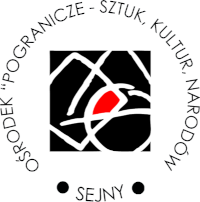History
The Jews were brought down to Sejny already in 1768 by the Dominicans who hoped for animation of the town's economics growth. They got the privilege to settle down in 1787, and four years later 72 Jews lived here already, in 1769 - three times more. Jewish community was developing rapidly and already in 1828 there were 2036 Jews among 3514 inhabitants. In 1880s. the Jews consisted approximately 75 percent of 4500 Sejny population.
Józef Adelson, Zarys dziejów Żydów w Sejnach. Katalog Miejsko-Gminnego Ośrodka Kultury (Outline of the history of the Jews in Sejny: Catalogue of the municipal-county cultural center), Sejny 1989
The earliest evidence of the existence of a Jewish center in Sejny dates to the end of the 17th century. From this period date the oldest inscriptions on the epitaphs in the no longer extant Jewish cemetery. In 1768, the Dominicans permitted the construction of a temple. This was the start of a rapid increase in the town’s Jewish population, which at the beginning of the 19th century, comprises more than 50% of the inhabitants, and throughout the century oscillates somewhere between 1,800 and 2,400. Emigration at the end of the 19th and beginning of the 20th centuries results in a marked decline in the numerical power of this population. According to figures from the last prewar census (1931), 819 Jews lived in Sejny, comprising 24% of all the town’s inhabitants. They were employed primarily in the trade of agricultural and forestry products as well as in craftsmanship. After the construction of the Augustowski Canal, many were employed as forest laborers in the transport and processing of wood. This may have been the typical work structure of the Jewish populace in the 19th and early 20th centuries, however, as early as the mid-19th century, not far from Sejny, in the countryside around the village of Kaleta, many farms organized on state land were leased to Jewish farmers in perpetuity. In 1865 the number of farms rose to 196, with the number of settlers on them at 1,208. Because the plot of land allotted them was rather small, these farmers were engaged primarily in the cultivation of vegetables and worked as hired laborers on the large Christian properties.
Sejny County had uncommon luck with respect to the religious and spiritual leaders in the Jewish community. Almost all of the rabbis in the 19th century in Sejny were prominent religious scholars, beginning with Rabbi Yehuda Baruch, who died in 1846, and ending with Rabbi Moses Becalel Lurii – the initiators of the construction of the 1885 synagogue, which still stands. Without doubt, the most prominent was Rabbi Moses Icchak Awigdor, who took over the office in 1846. Soon after his arrival in Sejny, this known organizer and religious philosopher opened a Yeshiva (higher Talmudic school) which had a folk-revolutionary character and became hugely famous amongst the Maskilis (advocates of the enlightenment of Jewish populace), attracting many students from the distant terrains of Russia and Poland. Thanks to the school, Sejny (granted though not for long) became the center of haskali (enlightenment) for the whole of Lithuania. It was here that the most prominent Lithuanian rabbis held their conferences. Soon, the tsarist regime, fearing the spread of Awigdor’s teachings on Polish territory and deep into Russia, closed the Yeshiva in Sejny and banished Awigdor. It was not only Awigdor’s Yeshiva that was renowned during this period for the quality of its Jewish education; in the mid-19th century, a Hebrew high school was established by the writer Tuwie Pinkas Szapiro in Sejny. It was one of the first Jewish schools of a secular character, where in addition to religion students were taught geography, mathematics, Russian and other subjects not usually encountered in the Jewish curriculae of the day. Some of the most enlightened minds in the Lithuanian Jewry were recruited from among the alumni of this high school.
Sejny was the birthplace of many distinguished personalities – scholars, inventors, politicians – who enriched not only the Jewish culture, but also the culture of the countries to which they emigrated, including the USA, France, England and Israel. Without doubt, the most prominent representative of the Jewish community in Sejny was born in 1862 in the village of Boksze: Moris Rozenfeld, poet, precursor of Yiddish poetry, creator of revolutionary songs and poems. In 1871, he moved with his parents to Warsaw only to return to Suwałki in 1875, where he married and, with the exception of a few short breaks (a stay in the USA and England), lived until 1886, at which time he emigrated permanently to the USA. There he debuted with a volume of poetry, “Di gloke”, publishing next a few volumes and selected poetry translated into English, French and German. His poem, “Mój chłopczyk” (My little boy), became one of the most popular songs of the English, German and Jewish proletariat. Rozenfeld died in the USA in 1923.
During the German occupation a small proportion of the Sejny Jews were saved on USSR soil; the rest perished in the concentration camps of Majdanek; a small number became Soviet partisans and left Poland after the war. This is how the almost 300-year Jewish presence in Sejny came to an end.




